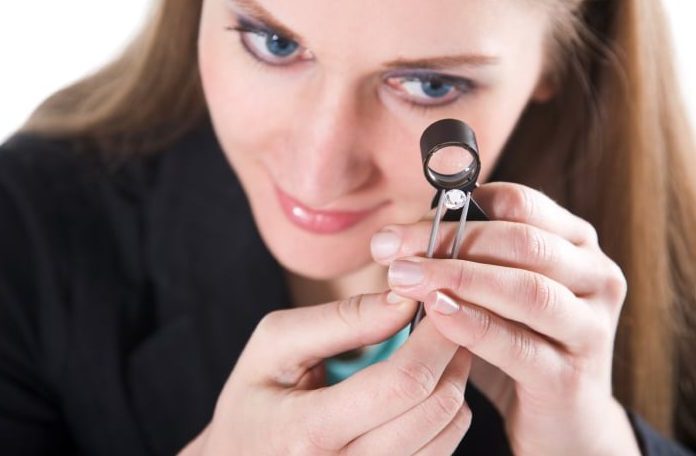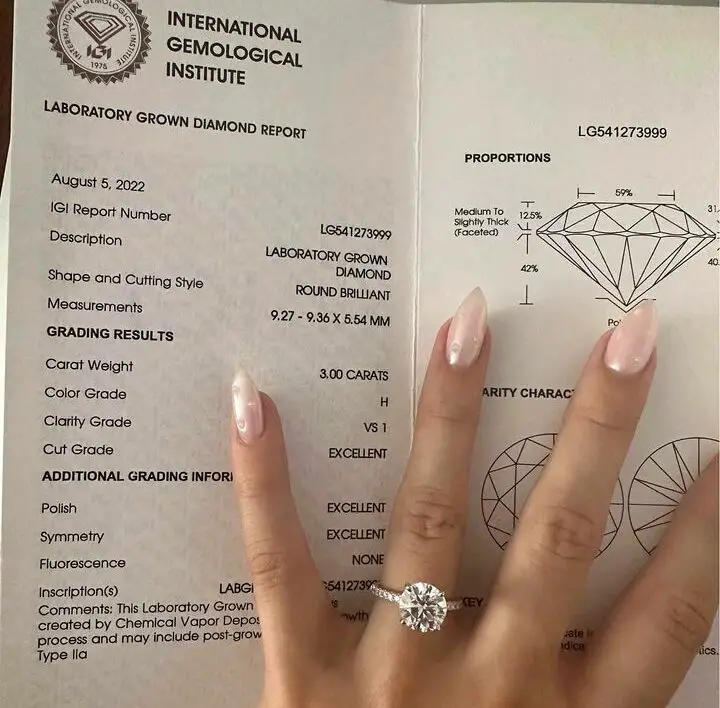Diamond Angle Demystified: How Diamond Cuts and Proportions Maximize Brilliance
Diamond cut quality is one of the most important factors in determining the beauty and value of a diamond. A well-cut diamond will reflect light brilliantly, maximizing sparkle and fire.
Diamond angle refers to the specific measurements and proportions of a diamond’s facets. These angles play a crucial role in determining how light interacts with the diamond, affecting its brilliance and sparkle. Properly cut diamonds with well-balanced angles can maximize their beauty and value.
Cut quality largely depends on achieving the proper angles and proportions in a diamond. In this article, we’ll discuss the anatomy of a round brilliant diamond and the ideal parameters to look for when selecting a diamond.
Anatomy of a Round Brilliant Diamond
First, it’s important to understand the different parts that make up a round brilliant diamond. A round brilliant diamond has three main sections:
Crown: The crown is the top portion of the diamond above the girdle. The crown is made up of bezel facets around the top of the diamond and star facets on the sides. The crown controls how light enters the diamond.
Girdle: The girdle is the narrow band around the widest part of the diamond, separating the crown above from the pavilion below. The girdle is sometimes faceted with extra facets.
Pavilion: The pavilion is the bottom portion of the diamond below the girdle. The pavilion is composed of pavilion main facets and terminates in the culet facet at the tip. The pavilion controls how light exits the stone.
The transition areas where these three sections meet are called the crown angle and the pavilion angle. The angles and proportions of these parts in relation to each other are what determines how well a round brilliant diamond is cut.
Importance of Diamond Cut Quality
Diamond cut quality refers to the skill with which a diamond is cut and polished from its rough crystal shape into a finished gemstone. The techniques and expertise of the cutter determines how well a diamond interacts with light to create desirable visual effects such as brilliance, fire, and scintillation.
When a diamond is cut with the proper proportions and angles, entering light is refracted and reflected internally to exit back out through the crown, releasing the diamond’s hidden beauty in a dazzling display. Light leakage through improperly cut facets results in less brilliance and value.
Understanding Diamond Angles
There are two primary angles to evaluate when analyzing the cut quality of a round brilliant diamond:
Crown Angle: The crown angle is the angle formed between the bezel facets and the girdle plane at the widest point of the diamond. The ideal crown angle range for a round brilliant diamond is 34-35 degrees.
Pavilion Angle: The pavilion angle is the angle formed between the pavilion main facets and the girdle plane at the widest point of the diamond. The ideal pavilion angle range is 40.6-41 degrees.
Achieving the optimal crown angle allows light to enter properly and undergo initial dispersion into the colors of the rainbow. The ideal pavilion angle enables light re-emerging from the pavilion to refract back out through the table, creating brilliance and sparkle.
Too steep or too shallow crown and pavilion angles cause light to misbehave, resulting in light leakage and less scintillation. Carefully cut crown and pavilion angles are essential for maximizing the optical performance of a round brilliant diamond.
Achieving Ideal Diamond Proportions
In addition to crown angle and pavilion angle, there are several other measurements that determine how well-proportioned a round brilliant diamond is cut. Striving for the following ideal parameters will help ensure optimal light refraction:
Table Diameter: Expressed as a percentage of the total diamond diameter, the table diameter represents the size of the large flat facet at the crown’s apex. Ideal table diameter is 53-57% of the total diameter.
Crown Height: The crown height is the distance from the girdle plane to the table facet, expressed as a percentage of the total diamond height. Ideal crown height is 13-16%.
Pavilion Depth: The pavilion depth is the distance from the girdle plane to the culet tip, expressed as a percentage of the total diamond depth. Ideal pavilion depth is 42-45%.
Total Depth: The overall depth percentage is the total distance from the table to the culet tip as a percentage of the average girdle diameter. Ideal total depth percentage is 59-62.5% for a round brilliant diamond.
Diamonds with measurements in these optimal proportion ranges tend to produce larger face-up diameters and exhibit maximum brilliance. Diamonds that deviate too far from these ideals often have diminished visual performance and lower value.
Finding the Right Diamond Angle and Proportions
When searching for a round brilliant diamond with excellent cut quality, carefully review the certificate from grading laboratories like GIA or AGS. An ideal cut diamond should have crown and pavilion angles in the recommended ranges. The table, crown height, pavilion depth, and total depth percentages should also conform to ideal targets.
Recommended Crown and Pavilion Angle Ranges: (for a Round Brilliant Diamond)
The recommended crown and pavilion angles for ideal cut diamonds can vary slightly depending on the specific diamond shape and the grading laboratory’s guidelines. However, I can provide you with approximate recommended ranges for round brilliant cut diamonds, which are the most common and have well-defined standards. *These ranges may serve as general guidelines, and slight variations can still result in excellent diamonds:
Excellent (Ideal) Cut:
- Crown Angle: 33.7 – 35.8 degrees
- Pavilion Angle: 40.6 – 41.8 degrees
- Table Percentage: 53% – 58%
- Crown Height Percentage: 14% – 16%
- Pavilion Depth Percentage: 42.5% – 43.5%
- Total Depth Percentage: 59% – 62.9%
Very Good Cut:
- Crown Angle: 32.2 – 33.6 degrees
- Pavilion Angle: 41.9 – 42.4 degrees
- Table Percentage: 53% – 63%
- Crown Height Percentage: 13.5% – 16.5%
- Pavilion Depth Percentage: 42.0% – 44.0%
- Total Depth Percentage: 57% – 63%
Good Cut:
- Crown Angle: 30.9 – 32.1 degrees
- Pavilion Angle: 42.5 – 43.0 degrees
- Table Percentage: 53% – 65%
- Crown Height Percentage: 13% – 17%
- Pavilion Depth Percentage: 41.5% – 44.5%
- Total Depth Percentage: 56% – 64%
Fair Cut:
- Crown Angle: 29.0 – 30.8 degrees
- Pavilion Angle: 43.1 – 43.7 degrees
- Table Percentage: 52% – 66%
- Crown Height Percentage: 12.5% – 17.5%
- Pavilion Depth Percentage: 41.0% – 45.0%
- Total Depth Percentage: 55% – 65%
Poor Cut:
- Crown Angle: Below 29.0 degrees or above 35.8 degrees
- Pavilion Angle: Below 40.6 degrees or above 43.7 degrees
- Table Percentage: 51% – 67%
- Crown Height Percentage: 12% – 18%
- Pavilion Depth Percentage: 40.5% – 45.5%
- Total Depth Percentage: Below 55% or above 65%
These angles are crucial in determining how well a round brilliant diamond interacts with light. Diamonds with crown and pavilion angles within the “Excellent Cut” range are more likely to exhibit maximum brilliance and sparkle. However, it’s important to note that other factors, such as table size, girdle thickness, and overall symmetry, also play a role in a diamond’s cut quality.
Asking the Right Questions
Here are some common diamond angle and proportion questions worth considering:
How are angles measured in a diamond?
The diameter, depth, crown height, and pavilion depth of a round brilliant diamond are measured in millimeters (mm). The crown angle, pavilion angle, and table diameter percentage use degrees and percentages respectively.
Do all diamonds have the same ideal angles and proportions?
The specific angles, depths, and diameter percentages recommended here are ideal parameters developed primarily for round brilliant diamonds to maximize light performance. Fancy shaped diamonds like pears, marquises, and emeralds have different standards for angles and proportions.
Why are diamond angles so important?
Achieving the perfect crown angle and pavilion angle in a round brilliant diamond allows incoming light to refract and reflect at the precisely calculated angles needed to create the most sparkle and brilliance. The right angles and proportions ensure light moves through the diamond properly.
How do angles affect price?
Diamonds with optimal crown and pavilion angles and excellent proportions exhibit superior light performance, sparkle, and brilliance. Well-cut diamonds demand higher prices compared to diamonds with poor cut quality. Bad angles and proportions negatively impact visual appeal and value.
Key Takeaways
A well-cut diamond with excellent optical symmetry and aligned facet shapes will scintillate vibrantly.
While factors like carat, color, and clarity influence price, you should invest in cut quality to maximize sparkle.
When selecting a diamond, look at the overall cut grade and proportions, as well as other factors like symmetry, polish, and fluorescence, to ensure you get a diamond that meets your specific desires for brilliance and appearance.
Diamonds with precisely calculated angles and geometry project light beautifully, exhibit desirable visual effects, and retain long-lasting appeal.


